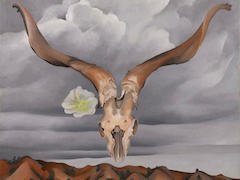Lake George, 1922 by Georgia O'Keeffe

From 1918 until 1934, Georgia O'Keeffe lived for part of the year at Alfred Stieglitz'sfamily estate in Lake George, located in New York's Adirondack Park. The thirty-six-acre property was situated along the western shore, in the southern basin of the thirty-mile-long glacial lake popularly known as "the Queen of American lakes." O'Keeffe typically stayed at Lake George from spring to fall and reveled in the discovery of new subject matter while finding respite in the bucolic setting of the Stieglitz property, a former farm. She enjoyed long walks through the wooded hillsides and hikes up Prospect Mountain to take in the spectacular view of the lake's mountain-rimmed waters. In her humble studio, nicknamed the "shanty," O'Keeffe found a place to concentrate on her work without the distractions of city life and the intrusions of the gregarious Stieglitz family who congregated at the lake house in the summer months. In 1923, she enthusiastically wrote to her friend, the writer Sherwood Anderson, "I wish you could see the place here - there is something so perfect about the mountains and the lake and the trees - Sometimes I want to tear it all to pieces - it seems so perfect - but it is really lovely - And when the household is in good running order - and I feel free to work it is very nice."
The majority of Georgia O'Keeffe's Lake George landscapes follow a similar compositional format of mountains stretching across the upper third of the picture, a long band of water at the center, and a stand of trees in the foreground. In this painting of the lake at dusk, however, O'Keeffe departs from the more familiar landscape composition by removing the shoreline, eliminating all extraneous details, and distilling the mountain and lake scenery to its most elemental forms. The artist pushed the boundaries between the descriptive and the abstract a step further by fusing the mountain and its mirrored image on the surface of the water as one unified abstract design. The image has a dual orientation and can be read horizontally, as a more conventional landscape or, if the canvas were turned on its side, the abstract forms would dominate.
















